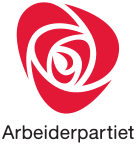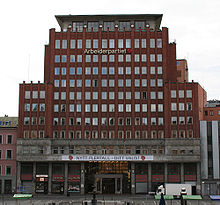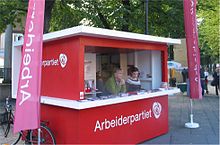- Labour Party (Norway)
-
Labour Party
Arbeiderpartiet
Leader Jens Stoltenberg Parliamentary leader Helga Pedersen Slogan "Alle skal med"
("Include everyone")Founded 1887 Headquarters Youngstorget 2 A, 5th floor Oslo Youth wing Workers' Youth League Membership 200,500 (peak, 1950)[1]
47,000 (2011)[2]Ideology Social democracy,
Democratic socialism[3]Political position Centre-Left International affiliation Socialist International * European affiliation Party of European Socialists Nordic affiliation SAMAK Official colours Red Parliament 64 / 169County Councils[4] 273 / 728Municipal / City Councils[5] 3,373 / 10,781Sami Parliament 14 / 39Website arbeiderpartiet.no Politics of Norway
Political parties
Elections
* Formerly member of Comintern (1919–1923) and Labour and Socialist International (1938–1940).The Labour Party (Norwegian: Arbeiderpartiet, A/Ap) is a social-democratic[6] political party in Norway. It is the senior partner in the current Norwegian government as part of the Red-Green Coalition, and its leader, Jens Stoltenberg, is the current Prime Minister of Norway.
The Norwegian Labour Party is officially committed to social-democratic ideals. Its slogan since the 1930s has been "work for everyone", and the party seeks a strong welfare state, funded through taxes and duties.[7] During the last 20 years, the party has included more of the principles of a social market economy in its policy, allowing for privatisation of government-held assets and services and reducing income tax progressivity, following the wave of economic liberalisation in the 1980s. The Labour Party profiles itself as a progressive party that subscribes to cooperation on a national as well as international level. Its youth wing is the Workers' Youth League.
Since its establishment in the late 19th century, the party steadily increased in support until it became the largest party in Norway in 1927 – a position it has held ever since. This year also saw the consolidation of conflicts surrounding the party during the 1920s following its membership of Comintern from 1919 to 1923. From 1945 to 1961, the party had an absolute majority in the Norwegian parliament, during which Norway was casually referred to as a "one party state". Since 1935, there have been only sixteen years in which the party has not held the office of the Prime Minister. The domination by the Labour Party, during the 1960s and early 1970s, was initially broken by competition from the left, primarily from the Socialist People's Party. From the end of the 1970s however, the party started to lose voters to the right, leading to a turn to the right for the party under Gro Harlem Brundtland during the 1980s. In 2001 the party achieved its worst electoral results since 1924, forcing it to commit to a co-operation agreement with other parties in order to form a majority government.[7]
Contents
History
The party was founded in 1887 in Arendal and first ran in elections to the Parliament of Norway in 1894. It entered Parliament in 1904 after the 1903 election, and steadily increased its vote until 1927, when it became the largest party.
From the establishment of Vort Arbeide in 1884, the party had a growing and notable organisation of newspapers and other press outlets. The party press system eventually resulted in A-pressen. In January 1913 the party had 24 newspapers, and 6 more newspapers were founded in the year 1913. The party also had the periodical Det 20de Aarhundre.[8] In 1920 the party had 33 newspapers and 6 semi-affiliated newspapers.[9] The party had its own publishing house, Det norske Arbeiderpartis forlag, succeeded by Tiden Norsk Forlag. In addition to books and pamphlets, Det norske Arbeiderpartis forlag published Maidagen (annual May Day publication), Arbeidets Jul (annual Christmas publication) and Arbeiderkalenderen (calendar).[10]
From its roots as a radical alternative to the political establishment, the party grew to its current dominance through several eras:
The party experienced a split in 1921 caused by a decision made two years earlier to join the Communist International, and the Social Democratic Labour Party of Norway was formed. In 1923 the party left the Communist International, while a significant minority of its members left the party to form the Communist Party of Norway. In 1927, the Social Democrats were reunited with Labour. Some Communists also joined Labour, whereas other Communists tried a failed merger endeavor which culminated in the formation of the Arbeiderklassens Samlingsparti.
The first Labour government, led by Christopher Hornsrud, was formed in 1928, lasting only two weeks. During the early 1930s Labour abandoned its revolutionary profile and set a reformist course. Labour then returned to government in 1935 and remained in power until 1965 (except for the World War II exile period between 1940–1945 and one month in 1963). During most of the first twenty years after World War II, Einar Gerhardsen lead the party and the country. He is often referred to as "Landsfaderen" (Father of the Nation), and is generally considered one of the main architects of the rebuilding of Norway after World War II. This is often considered the "golden age" of the Norwegian Labour Party.
The party was a member of the Labour and Socialist International between 1938 and 1940.[11]
Other periods of the Labour Party's leadership of the national government have been 1971-1972, 1973–1981, 1986–1989, 1990–1997, 2000–2001 and since 2005. Thus, the party has held power for 24 of the past 38 years (to 2009).
In the election in 2001 the party reached a low point of 24.3% of the popular vote, but was still the largest party in the Storting. In the election of 2005 the party regained support and received 32.7% of the popular vote. It is the leading partner in the centre-left Red-Green Coalition, which won a majority in the 2005 elections. Labour leader Jens Stoltenberg became prime minister and leads a coalition government (the first one that the Norwegian Labour Party has entered). He was previously prime minister from 2000 to 2001.
In 2011, the party changed its name from the Norwegian Labour Party (Det norske arbeiderparti) to the Labour Party (Arbeiderpartiet). The party claimed there had been confusion among voters at polling stations because of the difference between the official name, Norwegian Labour Party, and the colloquial name "Labour Party". The name change will cause Arbeiderpartiet to appear on the ballot, thus eliminating any potential confusion.[12][13]
On 22 July 2011, a gunman opened fire at the Labour Party's youth camp (ages 11-25), killing 69 people.
Party leaders
 Votes to the Labour Party in the 2009 election, by county
Votes to the Labour Party in the 2009 election, by county
 The Labour Party's number of seats in parliament by county after the 2009 election
The Labour Party's number of seats in parliament by county after the 2009 election
- Anders Andersen (1887–88)
- Hans G. Jensen (1888–89)
- Christian Holtermann Knudsen (1889–90)
- Carl Jeppesen (1890–92)
- Ole Georg Gjøsteen (1892–93)
- Gustav A. Olsen-Berg (1893–94)
- Carl Jeppesen (1894–97)
- Ludvig Meyer (1897–1900)
- Christian Holtermann Knudsen (1900–03)
- Christopher Hornsrud (1903–06)
- Oscar Nissen (1906–11)
- Christian Holtermann Knudsen (1911–18)
- Kyrre Grepp (1918–22)
- Emil Stang jr. (1922–23)
- Oscar Torp (1923–45)
- Einar Gerhardsen (1945–65)
- Trygve Bratteli (1965–75)
- Reiulf Steen (1975–81)
- Gro Harlem Brundtland (1981–92)
- Thorbjørn Jagland (1992–2002)
- Jens Stoltenberg (2002–present)
Labour Prime Ministers
- Christopher Hornsrud (1928: 26 January – 15 February)
- Johan Nygaardsvold (1935–1945)
- Einar Gerhardsen (1945–1951)
- Oscar Torp (1951–1955)
- Einar Gerhardsen (1955–1963)
- Einar Gerhardsen (1963–1965)
- Trygve Bratteli (1971–1972, 1973–1976)
- Odvar Nordli (1976–1981)
- Gro Harlem Brundtland (4 February – 14 October 1981, 1986–1989, 1990–1996)
- Thorbjørn Jagland (1996–1997)
- Jens Stoltenberg (2000–2001, 2005 – present)
Parliamentary election results
Campaign booth at Karl Johans gate ahead of the Norwegian local elections, 2007.
Year % of votes Members of the Storting 1894 0.3 0 out of 114 1897 0.6 0 out of 114 1900 5.2 0 out of 114 1903 12.1 4 out of 117 1906 15.9 11 out of 123 1909 21.5 11 out of 123 1912 26.2 23 out of 123 1915 32.0 19 out of 123 1918 31.6 18 out of 126 1921 21.3 29 out of 150 1924 18.4 24 out of 150 1927 36.8 59 out of 150 1930 31.4 47 out of 150 1933 40.1 69 out of 150 1936 42.5 70 out of 150 1945 41.0 76 out of 150 1949 45.7 85 out of 150 1953 46.7 77 out of 150 1957 48.3 78 out of 150 1961 46.8 74 out of 150 1965 43.1 68 out of 150 1969 46.5 74 out of 150 1973 35.3 62 out of 155 1977 42.3 76 out of 155 1981 37.1 65 out of 155 1985 40.8 71 out of 157 1989 34.3 63 out of 165 1993 36.9 67 out of 165 1997 35.0 65 out of 165 2001 24.3 43 out of 165 2005 32.7 61 out of 169 2009 35.4 64 out of 169 References
- ^ Røed, Lars-Ludvig (7 January 2009). "Lengre mellom partimedlemmene i dag". Aftenposten. http://www.aftenposten.no/fakta/innsikt/article2852464.ece.
- ^ Libell, Henrik Pryser (28 August 2011). "7 prosent vekst for ungdomspartiene siden 22/7" (in Norwegian). MandagMorgen. http://www.mandagmorgen.no/7-prosent-vekst-ungdomspartiene-siden-227. Retrieved 26 September 2011.
- ^ Prinsipp- og arbeidsprogram Det norske Arbeiderparti 1997
- ^ "Valg 2011: Landsoversikt per parti" (in Norwegian). Ministry of Local Government and Regional Development. http://www.regjeringen.no/krd/html/valg2011/bf5.html. Retrieved 18 September 2011.
- ^ "Arbeidarpartiet" (in Norwegian). Valg 2011. Norwegian Broadcasting Corporation. http://www.nrk.no/valg2011/valgresultat/parti/parti/a/. Retrieved 18 September 2011.
- ^ Parties and Elections in Europe
- ^ a b Arbeiderpartiet - Ørnen i Norge - Partiene - NRK Nyheter
- ^ Bjørnson, Øyvind (1990) (in Norwegian). På klassekampens grunn 1900-1920. Volume two of Arbeiderbevegelsens historie i Norge. Oslo: Tiden. p. 276. ISBN 82-10-02752-2.
- ^ Maurseth, Per (1987) (in Norwegian). Gjennom kriser til makt 1920-1935. Volume three of Arbeiderbevegelsens historie i Norge. Oslo: Tiden. p. 65. ISBN 82-10-02753-0.
- ^ Maurseth, 1987: p. 66
- ^ Kowalski, Werner. Geschichte der sozialistischen arbeiter-internationale: 1923 - 19. Berlin: Dt. Verl. d. Wissenschaften, 1985. p. 310
- ^ Slutt på Det norske Arbeiderparti
- ^ Arbeiderpartiet skifter navn
External links
- (Norwegian) Arbeiderpartiet - Official site
- (English) [1] - Information in English
- Election results for the Labour Party in the 2007 local elections
Norwegian Labour Party Leadership Andersen · Jensen · Knudsen · Jeppesen · Gjøsteen · Berg · Jeppesen · Meyer · Knudsen · Hornsrud · Nissen · Knudsen · Kyrre Grepp · Stang · Torp · Gerhardsen · Bratteli · Steen · Brundtland · Jagland · StoltenbergEriksen · Knudsen · Eriksen · Knudsen · Buen · Hornsrud · Scheflo · Madsen · Støstad · Madsen · Nygaardsvold · Støstad · Magnus Nilssen · Madsen · Monsen · Støstad · Torp · Gerhardsen · Hønsvald · Bratteli · Hansen · Bratteli · Nordli · Bratteli · Brundtland · Førde · Brundtland · Berge · Borgen · Jagland · Thoresen · Jagland · Stoltenberg · Solberg · Stoltenberg · Solberg · PedersenRelated topics History of the Norwegian Labour Party · Workers' Youth League · AUF membership scandal · Red-Green CoalitionPolitical parties in Norway Bracketed numbers indicate current numbers of seats in parliament.Parliament Labour (64) · Progress (41) · Conservative (30) · Socialist Left (11) · Centre (11) · Christian Democratic (10) · Liberal (2)Minor parties1 Red (1.3%) · Pensioners (0.4%) · Green (0.3%) · Coastal (0.2%) · Christian Unity (0.2%) · Democrats (0.1%)1 by % of vote in most recent general election.Parties Member parties (EU)Member parties (non-EU)Associated parties (EU)Associated parties (non-EU)Observer partiesParty Presidents Wilhelm Dröscher · Robert Pontillon · Joop den Uyl · Vítor Constâncio · Guy Spitaels · Willy Claes · Rudolf Scharping · Robin Cook · Poul Nyrup RasmussenEuropean Parliament
Group PresidentsGuy Mollet · Hendrik Fayat · Pierre Lapie · Willi Birkelbach · Käte Strobel · Francis Vals · Georges Spénale · Ludwig Spénale · Ernest Glinne · Rudi Arndt · Jean-Pierre Cot · Pauline Green · Enrique Barón Crespo · Martin Schulz · see European Parliament
European Commissionners Catherine Ashton (Foreign Affairs and Security Policy) · Joaquín Almunia (Competition) · Maroš Šefčovič (Inter-Institutional Relations and Administration) · Maria Damanaki (Maritime Affairs and Fisheries) · Štefan Füle (Enlargement and European Neighbourhood Policy) · László Andor (Employment, Social Affairs and Inclusion) · see Barroso II CommissionHeads of government
at the European CouncilWerner Faymann (Austria) · George Papandreou (Greece) · Borut Pahor (Slovenia) · José Luis Rodríguez Zapatero (Spain) · see European CouncilEurofoundation: Foundation for European Progressive StudiesCategories:- Political parties in Norway
- Social democratic parties
- Socialist International
- Labour Party (Norway)
- Party of European Socialists member parties
- Political parties established in 1887
- 1887 establishments in Norway
- Second International
- Comintern sections
- Members of the Labour and Socialist International
Wikimedia Foundation. 2010.



